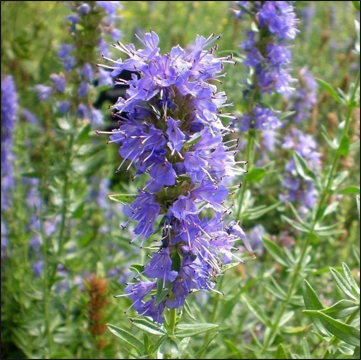What are the Uses and Health Benefits of Hyssop (Hyssopus officinalis)?

Hyssopus officinalis is a well-known medicinal, aromatic and culinary herb. It is a native of South European countries. In India, it is found in the Western Himalayan region from Kashmir to Kumaun altitudes of 8,000-11,000 ft. The genus Hyssopus comprises of aromatic perennial herbs or sub-shrubs which are known for their medicinally and culinary properties. The leaves of this plant are commonly used as an aromatic condiment. Medicinally, it is used as an expectorant, anti-inflammatory, carminative, anti-catarrhal and anti-spasmodic in different parts of the world.
This plant has been used for medicinal purposes since long and it was regarded as ‘relieve-all’ herb. Even today, this herb is used as a household remedy for the treatment of sore throat and stomach related problems.
Plant Description
Hyssop is a perennial plant and belongs to mint family. This family contains a wide variety of medicinal herbs. It has woody stem at the base. Its leaves are lanceolate, 2-2.5 cm long and dark green in colour. The leaves have small hair-like structure, have a pleasant odour and bitter taste. The flowers also have a pleasant odour and have pinkish to purplish colour. The fruit is brown in colour and triangular in shape. The blooming period of flowers is from July to September.
- Botanical Name: Hyssopus officinalis
- Family: Lamiaceae
- Hindi Name: Jupha
- English Name: Hyssop
- Urdu Name: Zufah
Medicinal Properties of Hyssopus officinalis
- Taste (Rasa): Pungent (Katu) and Bitter (Tikta)
- Qualities (Guna): light to digest (laghu), dry in nature (ruksha) and strong (teekshana)
- Vipaka: katu (undergoes pungent taste conversion after digestion).
- Potency (Veerya): Hot
- Effect on Tridosha: Balances Vata and Kapha dosha.
- Part Used: Whole plant
Pharmacological Characteristics
H. officinalis exhibits various pharmacological activities i.e. anti-bacterial, anti-fungal, spasmolytic, anti-viral, cytotoxic, anti-platelet etc. The anti-bacterial, anti-fungal and anti-oxidant properties of this plant are attributed due to the presence of pinocamphone and iso-pinocamphone.
The anti-viral property of this plant is attributed due to the presence of tannins and caffeic acid.
Health Benefits of Hyssopus officinalis
- Wound healing: Due to anti-bacterial and anti-fungal properties of this plant, the paste of its leaves is applied over the wounds for healing.
- A tea made from the leaves of Hyssopus officinalis is used in the treatment of stomach ache, respiratory tract infections, cough etc. The decoction in the dose of 25 ml of its leaves is used in the treatment of intestinal worms.
- The fresh juice of its flowers and leaves in the dose of 10 ml is administered to treat constipation and distension of abdomen.
- To treat headache and rhinitis, the paste of its leaves are applied over the forehead.
- To treat respiratory tract infections, the juice of its leaves with honey is quite effective.
- For hepatomegaly and fever, the cold infusion of its leaves in the dose of 40 ml is quite effective.
- The paste of its leaves when applied on the insect bites and stings helps to relieve pain.
- The extract of this herb is very effective in providing relief from menstrual cramps.
- As a peripheral vasodilator, it has diaphoretic (sweat inducing) and anti-inflammatory properties. The sweat inducing properties of this herb may relieve the symptoms in patients with fever.
- The poultice of this plant helps in the treatment of conjunctivitis. To prepare poultice, the fresh or dried leaves of the plant should be soaked in boiling water for 15 minutes and place on a cloth for application. The crushed fresh leaves can be applied directly to the skin for similar effects.
Some of Its Culinary Uses
- The fresh leaves of this plant are used for cooking purposes.
- In Middle East, the dried leaves of this plant are included in spice mixtures.
Adverse Effects
- Since this plant has a strong odour, it can cause epileptic attack in a person who is susceptible to strong odour.
- In excess, the essential oil of this plant can cause increased intestinal movement and diarrhea.
- This herb is not recommended for use in younger children because its essential oil contains pino-camphone. It is a ketone that can cause convulsions and seizures when taken in high doses.
- It is not advisable to take its oil and other preparations in high doses internally over a long time.



